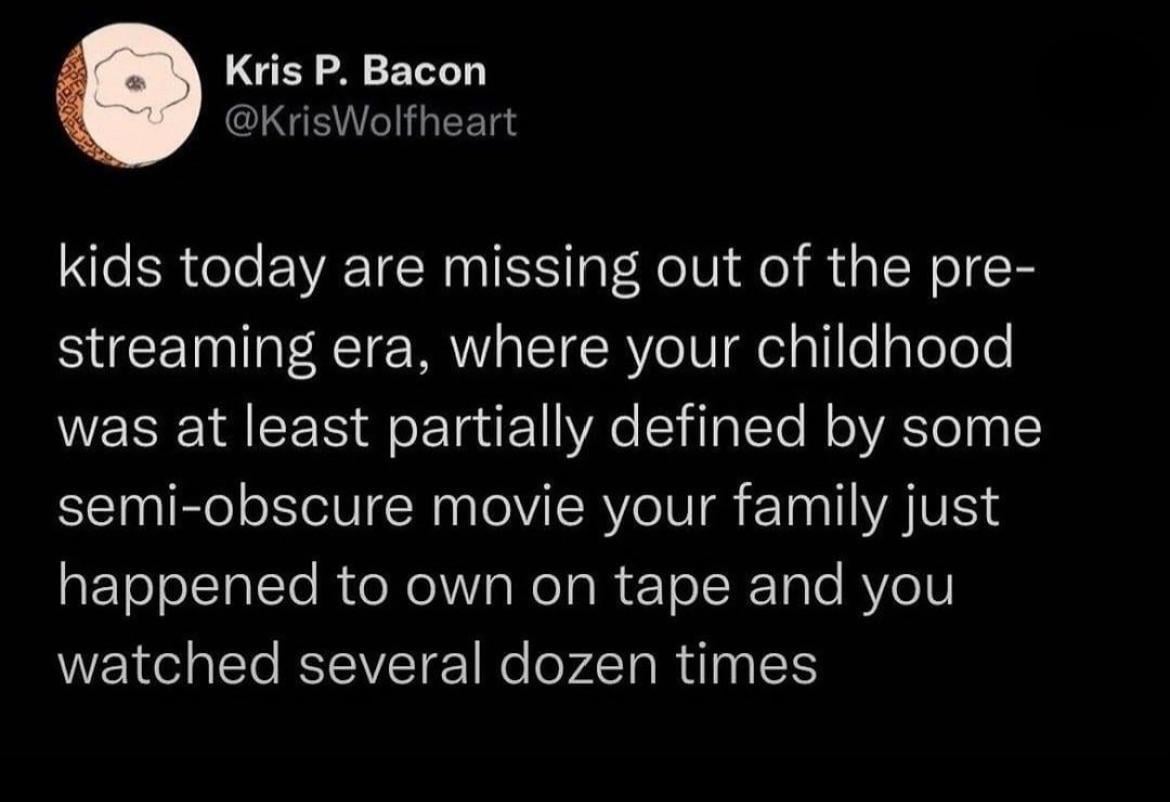this post was submitted on 24 Aug 2024
1300 points (98.9% liked)
People Twitter
5213 readers
2111 users here now
People tweeting stuff. We allow tweets from anyone.
RULES:
- Mark NSFW content.
- No doxxing people.
- Must be a tweet or similar
- No bullying or international politcs
- Be excellent to each other.
founded 1 year ago
MODERATORS
you are viewing a single comment's thread
view the rest of the comments
view the rest of the comments

Wait wouldn’t stripes get longer the lower the tape speed?
Nope. The tape travels a shorter distance in each 60th of a second, so there's a steeper diagonal between the start and end of each frame. The whole magnetic pattern gets scrunched.
I don’t understand what you’re saying.
Why would the stripes be longer, if the tape travels less distance, in the time it takes to make one stripe?
I think I don't understand the stripes thing. so it's a diagonal stripe. are the edges of the tape the sides of the screen or the top and bottom of the screen? what do you mean by steeper? is there a a gap between frames? how is the gap created? why would putting less information onto the tape (standard play vs long play) cause less readable data and lower quality? usually packing more into a given space makes quality worse.
Getting a millennial to explain CRTs is the free space in our bingo card.
Okay, so: tube televisions are a glass bulb containing vacuum. There's an electron beam at the back, and electromagnets steer that beam in straight lines left to right, from the top of the screen to the bottom, every single frame. But in-between each straight line there's a brief "blanking interval" where the beam has to move to the next line. The video signal itself goes dark during these periods. There's a longer "vertical blank" when the beam moves from the bottom-right corner back to the upper-left.
VHS encodes one sequence of lines, one frame, from the top edge of the tape to the bottom edge of the tape. The tape is pulled around a drum, and inside the drum, there's a read-write head spinning perpendicular. If the tape stopped then it'd overwrite the same vertical stripe across the tape, top to bottom, over and over. But because the tape is moving around the drum, it writes each stripe diagonally, slightly separated from the previous stripe.
It's okay to lose some signal between the bottom of one stripe and the top of the next, because there's not supposed to be any signal. That's the vertical blank.
Magnetic media has limited "response." You can only cram so much signal onto it before everything smears together, and you lose information. When VHS moves the tape more slowly, each stripe is closer to vertical, and also closer to its adjacent stripes.
Limited response is the reason for all of this. Industrial video recording just records linearly - like audio cassettes. But to do that, the tape has to move much faster, to avoid losing information. Studio-quality tapes come on enormous reels. VHS is compact, and moves at a more manageable speed, because the head moves quickly, even though the tape does not.
I am a millennial. An older one at that. And I did already know how CRTs worked, but thank you. My question was how running slower, which usually means encoding information more stabily (think of any HDD and how it took a long time to get to the point where we could even run the disks at higher speeds), would mean the information is worse. I’m still not sure my question was answered. I’m guessing it has to do with the size of the write head, and maybe you are trying to say that the write head only has one speed, which would explain the problem a bit more. Therefore the slow tape speed wouldn’t result in any finer detail because the write head can’t write any finer grained, it has nothing to do with the speed of the tape.
Running slower means you have less space.
Dude, think of it like a photograph. If you had a lens that could squeeze a square frame into a narrower rectangle, you could advance the film any distance between frames, and scrunch the image to take up that much space. But the slower the film moves - the less distance there is between frames - and the scrunchier each image gets. There's an upper limit to how much detail any given area can capture. The film grain quickly becomes visible. When the image gets blown back up to its regular shape, some of the information has been lost, because the medium has finite detail.
A slow hard drive takes longer to access information. Video tape doesn't work that way. It displays in real time. When it moves at one inch per second, every frame gets 1/60th of an inch.
And at some point, it doesn't matter how much detail the head tries to write - the tape itself has limits. There are physical bits of metal, suspended in goo, stuck to clear plastic. The engineers of the format chose the lowest tape speed that could hold enough information for a picture with acceptable quality. If they could have stored the same information by running slower - they would have. And it would save the manufacturer a shitload of money, since they'd need less physical tape inside each cassette.